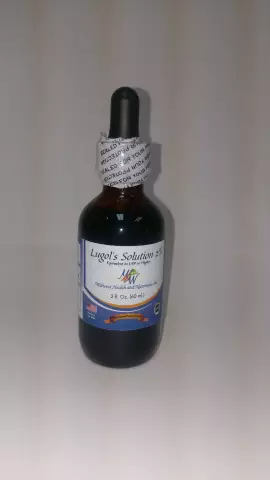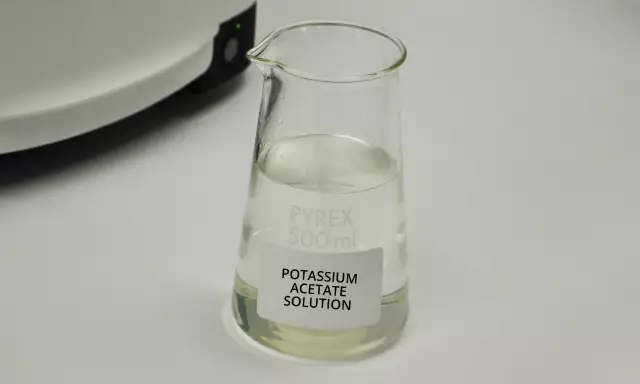- Author Rachel Wainwright [email protected].
- Public 2023-12-15 07:39.
- Last modified 2025-11-02 20:14.
Nephrotect
Nephrotect: instructions for use and reviews
- 1. Release form and composition
- 2. Pharmacological properties
- 3. Indications for use
- 4. Contraindications
- 5. Method of application and dosage
- 6. Side effects
- 7. Overdose
- 8. Special instructions
- 9. Application during pregnancy and lactation
- 10. Use in childhood
- 11. Drug interactions
- 12. Analogs
- 13. Terms and conditions of storage
- 14. Terms of dispensing from pharmacies
- 15. Reviews
- 16. Price in pharmacies
Latin name: Nephrotect
ATX code: B05XB
Active ingredient: amino acids for parenteral nutrition (Aminoacids for parenteral nutrition)
Producer: Fresenius Kabi Austria, GmbH (Austria)
Description and photo update: 09.10.2019

Nephrotect is an agent for parenteral nutrition.
Release form and composition
Dosage form - solution for infusion: slightly opalescent or transparent, from colorless to pale yellow, with a pH of 5.5 to 6.5 (in a cardboard box there are 10 bottles of colorless glass containing 250 or 500 ml of solution, with / without plastic holders included, as well as instructions for the use of Nephrotect).
Active substances in 1 liter of solution:
- L-isoleucine - 5.8 g;
- L-leucine - 12.8 g;
- L-lysine monoacetate - 16.925 g (corresponds to the content of L-lysine - 12 g);
- L-methionine - 2 g;
- L-phenylalanine 3.5 g;
- L-threonine 8.2 g;
- L-tryptophan - 3 g;
- L-valine - 8.7 g;
- L-arginine 8.2 g;
- L-histidine - 9.8 g;
- L-alanine - 6.2 g;
- N-acetyl-L-cysteine - 0.54 g (corresponds to the content of L-cysteine - 0.4 g);
- glycine - 5.305 g;
- L-proline - 3 g;
- L-serine 7.6 g;
- L-tyrosine - 0.6 g;
- glycyl-L-tyrosine (anhydrous) - 3.155 g.
Auxiliary components: malic acid - 2.01 g; glacial acetic acid - from 2.5 to 4 g; water for injection - up to 1 liter.
The total amino acid content is 100 g per liter, nitrogen - 16.3 g per liter.
The theoretical osmolarity is 935 mOsm per liter.
Pharmacological properties
Pharmacodynamics
Nephrotect is a solution containing nonessential and essential amino acids that replenish the loss of amino acids during dialysis and parenteral nutrition, necessary for the body to synthesize protein and achieve a positive nitrogen balance. The drug is specially designed for patients with impaired renal function.
Pharmacokinetics
With intravenous (i / v) administration of the solution, amino acids enter the body, which are anabolically utilized and incorporated into proteins when energy substrates are available. The bioavailability of Nephrotect with intravenous administration is 100%.
With intravenous administration, the distribution of amino acids is similar to that of their intake from the gastrointestinal tract during the hydrolysis of food proteins.
Glycyl-L-tyrosine, which is part of the drug, is an additional source of L-tyrosine, which immediately after intravenous administration is hydrolyzed with subsequent utilization of the amino acids L-tyrosine and glycine, including in patients with renal insufficiency. Its half-life is 3.44 minutes.
A small part of the incoming amino acids is lost with urine, provided that the solution is introduced at the recommended rate.
Indications for use
- hemo- or peritoneal dialysis (to replace the loss of amino acids);
- full or partial parenteral nutrition of patients with impaired renal function, including parenteral nutrition in acute / chronic renal failure, including in patients on hemo- or peritoneal dialysis (for the purpose of introducing amino acids into the body).
Contraindications
Absolute:
- shock (acute phase);
- congenital disorders of amino acid metabolism;
- decompensated hypotonic dehydration, decompensated heart failure, overhydration, acute pulmonary edema (general contraindications for infusion treatment);
- individual intolerance to the components of the drug.
Relative (Nephrotect solution is prescribed under medical supervision):
- hyponatremia;
- increased blood osmolarity;
- pregnancy;
- period of breastfeeding;
- children under 18 years of age.
Nephrotect, instructions for use: method and dosage
Nephrotect solution is administered intravenously. The dosage of the drug is selected separately for each patient, taking into account their individual needs.
Recommended dosage regimen:
- acute and chronic renal failure in patients not receiving hemo- or peritoneal dialysis: from 0.6 to 0.8 g of amino acids per 1 kg of body weight per day (which corresponds to 6-8 ml of solution per 1 kg of body weight per day);
- acute and chronic renal failure in patients on hemo- or peritoneal dialysis: from 0.8 to 1.2 g of amino acids per 1 kg of body weight per day (which corresponds to 8-12 ml of solution per 1 kg of body weight per day);
- hemo- or peritoneal dialysis (to replenish the loss of amino acids): from 0.5 to 0.8 g of amino acids per 1 kg of body weight per day (which corresponds to 5-8 ml of solution per 1 kg of body weight per day).
The maximum recommended daily dose for children and adults is from 0.8 to 1.2 g of amino acids per 1 kg of body weight per day (which corresponds to 8-12 ml of solution per 1 kg of body weight per day). For patients weighing 70 kg, the daily dose is approximately 560 to 840 ml of solution.
Nephrotect is recommended to be administered at a rate not exceeding 0.1 g of amino acids per 1 kg of body weight in 1 hour (1 ml of solution per 1 kg of body weight in 1 hour) with parenteral nutrition and 0.2 g of amino acids per 1 kg of body weight in 1 h (2 ml of solution per 1 kg of body weight per hour) in cases of replenishing the loss of amino acids during hemo- or peritoneal dialysis.
In most cases, any solutions containing amino acids during parenteral nutrition are used in combination with drugs that are energy sources - fat emulsions and / or glucose solutions. For patients on complete parenteral nutrition, the drug is prescribed in combination with fat-soluble and water-soluble vitamins and microelements, electrolytes and energy sources.
Together with other drugs for parenteral nutrition, Nephrotect, depending on the end osmolarity, can be injected into both the central and peripheral veins.
The solution can be administered through a separate infusion system or mixed under aseptic conditions with other components of parenteral nutrition and introduced into a container.
In order to replenish the loss of amino acids during dialysis, the drug can be injected directly into the venous trap of the dialysis apparatus without glucose solutions and fat emulsions.
Nephrotect can be used as long as the patient has a need to replenish the loss of amino acids or he needs parenteral nutrition.
Side effects
Adverse events in cases of adherence to the administration technique, use of the drug in the recommended doses and taking into account contraindications were not observed.
As with any amino acid solutions, in rare cases, against the background of the use of Nephrotect, the following side effects can develop: difficulty breathing, an increase in the level of eosinophils, swelling of the extremities, scleroderma, muscle pain.
Overdose
Data on an overdose of Nephrotect were not provided.
special instructions
During the period of Nephrotect therapy, it is recommended to monitor the following indicators:
- serum electrolyte levels;
- fluid balance;
- acid-base state;
- ammonium and urea levels.
The drug can be mixed or administered simultaneously with electrolytes or energy carriers in quantities that are necessary for the patient to meet his needs.
In children with impaired renal function, administration of amino acids through parenteral nutrition can be vital. In such cases, the solution can be used in patients of this age group. For children, tyrosine is an essential amino acid.
Application during pregnancy and lactation
Nephrotect during pregnancy / lactation is used with caution, after correlating the expected benefits of using the drug for the mother with the possible risks to the fetus / child.
With parenteral nutrition in the presence of impaired renal function, the introduction of amino acids can be vital. If necessary, amino acid solutions can be used during pregnancy and during breastfeeding. The development of adverse events during their use in patients of these groups was not observed. No teratogenic effects have been identified.
Pediatric use
For patients under 18 years of age, Nephrotect can be prescribed only after assessing the potential benefits of its use and possible risks.
Drug interactions
Nephrotect, like other amino acid solutions, can be mixed under aseptic conditions only with preparations intended for parenteral nutrition, including electrolytes, glucose solutions and fat emulsions.
Due to the risk of incompatibility, the combined use of the solution with drugs of other groups is not recommended.
Analogs
Analogs of Nephrotect are Hymix, Dipeptiven, Aminosol-Neo, Aminoven Infant, Aminoplasmal Hepa, Aminoven.
Terms and conditions of storage
Store in a place protected from light and moisture at temperatures up to 25 ° C. Keep out of the reach of children. Do not freeze.
Shelf life is 2 years.
Terms of dispensing from pharmacies
Released for hospitals.
Reviews about Nephrotect
In view of the specific use of the drug in a hospital setting, there are few reviews about Nephrotect, confirming its effectiveness.
Price for Nephrotect in pharmacies
The approximate price for Nephrotect (in a package of 10 glass bottles of 250 ml of solution) is 3800-5950 rubles.

Anna Kozlova Medical journalist About the author
Education: Rostov State Medical University, specialty "General Medicine".
Information about the drug is generalized, provided for informational purposes only and does not replace the official instructions. Self-medication is hazardous to health!






